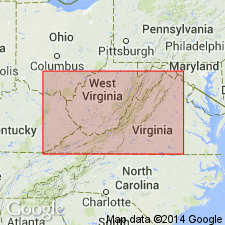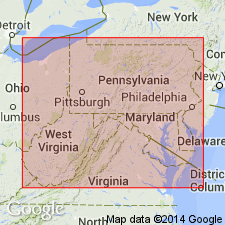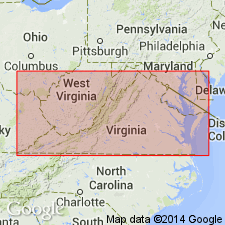
- Usage in publication:
-
- Cloyd conglomerate member
- Modifications:
-
- Named
- Dominant lithology:
-
- Conglomerate
- Sandstone
- AAPG geologic province:
-
- Appalachian basin
Summary:
Cloyd conglomerate member at base of Price formation described as coarse-grained white quartz sandstone with lenses and layers of conglomerate with quartz pebbles as much as 1.5 in. in diameter. Name Ingles conglomerate has been applied to this sandstone because similar sandstone occurs in Ingles Mountain a few miles southeast of Radford. Sandstone in Ingles Mountain, however, is Clinch sandstone; therefore, name Cloyd is here substituted for Ingles in southwestern VA.
Source: GNU records (USGS DDS-6; Reston GNULEX).

- Usage in publication:
-
- Cloyd Conglomerate Member
- Modifications:
-
- Age modified
- Biostratigraphic dating
- AAPG geologic province:
-
- Appalachian basin
Summary:
Age of the Price Formation in West Virginia is documented by three brachiopod fauna. The oldest two are of very late Devonian (late Famennian) age and are found in outcrops north of the West Virginia dome, at Hendricks and Rowlesburg, West Virginia, and Summit, Pennsylvania. The youngest fauna described here is of very early Carboniferous (early Kinderhookian age) and is widespread to the south. Therefore, Price Formation considered time-transgressive from northern to southern West Virginia. This concept supported by Kammer and Bjerstedt (1986) who reported Osagean fauna in extreme southern West Virginia. This conflicts with Englund and others (1988 [abs.], AAPG Bull. v. 72, p. 961) who view the Price as time-transgressive from south to north. Cloyd Conglomerate Member, base of Price at Caldwell, West Virginia, contains late Famennian brachiopods, while conformably overlying Riddlesburg is early Kinderhookian.
Source: GNU records (USGS DDS-6; Reston GNULEX).

- Usage in publication:
-
- Cloyd Conglomerate Member
- Modifications:
-
- Overview
- AAPG geologic province:
-
- Appalachian basin
Summary:
Price Formation, approximate equivalent of the Pocono Formation of northern VA, tops the Mason Cove plane table section near the crest of Fort Lewis Mountain. The Cloyd Conglomerate Member occurs 15 m above the underlying Hampshire Formation. Although a second bed of Cloyd-like conglomerate about 200 m above the basal Cloyd was recognized by Kreisa and Bambach (1973), authors here restrict the usage to the 3-m-thick bed near the base of the Price, which conforms to its description at the type locality. Authors also accept the 152-m thickness for the Price reported by Amato (1974) rather than the 350-m thickness reported by Kreisa and Bambach. Base of the Sunbury Shale Member used to mark the Devonian-Mississippian boundary, in agreement with Bjerstedt and Kammer (1988). Therefore age of the Cloyd is considered latest Devonian and age of the Price, latest Devonian and Early Mississippian.
Source: GNU records (USGS DDS-6; Reston GNULEX).
For more information, please contact Nancy Stamm, Geologic Names Committee Secretary.
Asterisk (*) indicates published by U.S. Geological Survey authors.
"No current usage" (†) implies that a name has been abandoned or has fallen into disuse. Former usage and, if known, replacement name given in parentheses ( ).
Slash (/) indicates name conflicts with nomenclatural guidelines (CSN, 1933; ACSN, 1961, 1970; NACSN, 1983, 2005, 2021). May be explained within brackets ([ ]).

